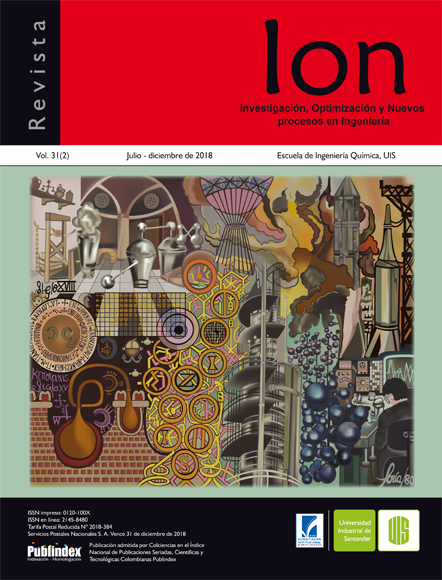CIC-Erosion: computational tool for predicting erosive wear in transport and production pipelines of hydrocarbons
Published 2019-01-16
Keywords
- Computational Tool,
- Empirical Models,
- C# Programming Language,
- Erosion,
- Fluid Transport
How to Cite
Abstract
The mechanical integrity of pipeline walls in the system components used in hydrocarbons production and transportation can be compromised by the erosion caused by the continuous impact of suspended solids. The implementation of methods or models to monitor and predict erosive wear is an important tool for the oil industry. The results from simulations and prediction models can aid in the calculation and determination of line sizes and maximum flow velocities to control and regulated wall erosion. In this work, we present a structured and selective calculation methodology to improve the implementation of models and the analysis and interpretation of erosion data for the prediction of erosive wear in transport pipelines. A computational tool (CIC-Erosion) written in C# programming language was developed to bring the methodology to a practical operational state. To develop and assure the operational functionality of the CICErosion tool, the following activities were performed: a) definition of software architecture, b) programming of the user interface and theoretical foundations, c) evaluation of the software operational functionality; using experimental erosion rate data reported in the literature and information from hypothetical case studies. Finally, the capacity to predict the behavior of the erosion calculation methodology was assessed using experimental data from case studies identified in the crude oil production of a field located in Colombia. When the predictive capacity of the software was evaluated, a good agreement between results obtained with the erosion calculation methodology and the experimental data was observed. Therefore, the CIC-Erosion computational tool can be considered an efficient and reliable alternative for the prediction of erosive wear in infrastructure used in the hydrocarbon industry.
Downloads
References
[2] Schlumberger. Recuperación del control de la producción de arena. Houston, Estados Unidos: 2007.
[3] American Petroleum Institute. API RP-14E Recommended practice for design and installation of offshore production platform piping systems. 5th Edition, Washington DC, USA: API, 1991.
[4] Salama M. An alternative to API 14E erosional velocity limits for sand-laden fluids. J. Energy Resour. Technol. ASME. 2000;122(2):71-7.
[5] McLaury BS, Shirazi SA, Rybicki EF. How operating and environmental conditions effect erosion. En: NACE International Annual Conference; 1999 Marzo; Houston, USA. Houston: 1999. Paper No 34.
[6] Salama MM, Venkatesh ES. Evaluation of API RP 14E erosional velocity limitations for offshore gas wells. En: 15th Annual Offshore Technology Conference; 1983 Mayo 2-5; Houston, USA. Houston: 1983. p. 371-6
[7] Det Norske Veritas. DNV RP O501 Recommended practice erosive wear in piping systems. Revisión 4.2, Noruega; DNV, 2007.
[8] Shirazi SA, Shadley JR, McLaury BS, Rybicki EF. A procedure to predict solid particle erosion in elbows and tees. J. Pressure Vessel Technol. 1995;117(1):45-52.
[9] McLaury BS, Shirazi SA. An alternate method to API RP 14E for predicting solids erosion in multiphase flow. J. Energy Resour. Technol. ASME. 2000;122(3):115-22.
[10] Mazumder QH, Shirazi SA, McLaury BS. A mechanistic model to predict sand erosion in multiphase flow in elbows downstrean of vertical pipes. En: NACE International Annual Conference; 2004 Marzo; Houston, USA. Houston: 2004. Paper No 04662.
[11] Mazumder QH. Prediction of erosion due to solid particle in single-phase and multiphase flows. J. Pressure Vessel Technol. ASME, 2007;129(4):576-82.
[12] Mazumder QH, Shirazi SA, McLaury BS. Prediction of solid particle erosive wear of elbows in multiphase annular flow-model development and experimental validations. J. Energy Resour. Technol. ASME. 2008;130(2):023001-1-023001-10.
[13] Glaso O. Generalized pressure-volume-temperature correlations. JPT. 1980;32(5):785–95.
[14] Beggs HD, Robinson JR. Estimating the viscosity of crude oil systems. JPT. 1975;27(9):1140-1.
[15] Standing MB. Volumetric and phase behavior of oil field hydrocarbon systems. USA: Millet the Printer, Inc.; 1977.
[16] Ahmed T. Reservoir engineering handbook. USA: Elsevier; 2010.
[17] Ghassan HA, Nimat B. Estimation of gas–oil surface tension. J. Pet. Sci. Eng. 2000;27(3-4):197-200.
[18] Meehan DN. A Correlation for water compressibility. Petroleum Engineer. 1980:125–126.
[19] American Petroleum Institute. API RP 581 Risk-Based Inspection Technology. 2th Edition, Washington DC, USA: API, 2008.
[20] Sastri SRS, Rao KK. A simple method to predict surface tension of organic liquids. Chem. Eng. J.1995;59(2):181-6.
[21] Poling BE, Prausnitz JM. O ́Connell JP. The properties of gases and liquids. USA: McGraw-Hill; 2004.
[22] Taitel Y, Dukler AE. A model for predicting flow regime transitions in horizontal and near horizontal gas-liqid flow. AIChE Journal. 1976;22(1):47-55.
[23] Ansari AM, Sylvester ND. A mechanistic model for upward bubble flow in pipes. AIChE J. 1988;34(8):1392-4.
[24] Jerez M, Jaramillo JE, Fuentes D. Prediction of multiphase flow in pipelines: literature Review. Ingeniería y Ciencia. 2015;11(22):213-33.
[25] Meng HC, Ludema KC. Wear models and predictive equations: their form and content. Wear. 1995;181-183:443-57.
[26] Parsi M, Najmi K, Najafifard F, Hassani S, McLaury B, Shirazi SA. A comprehensive review of solid particle erosion modeling of oil and gas wells and pipelines applications. J. Nat. Gas Sci. Eng. 2014;21:850-73.

